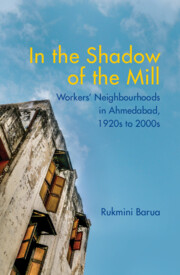Introduction
Published online by Cambridge University Press: 15 June 2022
Summary
A fable about the founding of Ahmedabad reflects the recurring pattern of change in the city. When in the early fifteenth century, Sultan Ahmad Shah began building the city walls, the day's construction would be mysteriously destroyed every night and the next morning, work would have to begin anew. Legend had it that a local saint, Manek Nath, unhappy with these developments, had cast a spell. As the walls were being built during the day, Manek Nath would weave a magical blanket. Every night, he would then unravel the blanket, this magical gesture bringing down the city walls. There are different versions of the resolution of this conflict. In one, Manek Nath relented because Ahmad Shah agreed to name a part of the city after him. In another, the saint was tricked into trapping himself in a bottle. The constant dynamic of weaving and unweaving recurs through the city's history. It is visible in the partial disintegration of the handloom industry and the growth of the textile mills from the mid-nineteenth century onwards. The motif reappears when the textile industry collapsed in the mid-1980s and industrial restructuring enabled the expansion of power-looms and other industries. It is visible again in the settling and unsettling of city spaces, in the knitting and unspooling of social relations. As Ahmedabad's neighbourhoods grew, its socio-spatial relations transformed. Older spatial and social forms and practices were not simply supplanted by newer ones. Instead, as this research demonstrates, they were overlaid and, in turn, were often enmeshed with the newer forms and practices. While the analogy of weaving and unravelling offers us a productive lens through which to view the city's history, it was not an unambiguous, unidirectional process. It is this tension—of the often simultaneous and interlinked processes of building and dismantling—that this book is set against.
Two broad historical processes—industrial transformation and communalisation—frame the questions that I seek to address. The expansion and decline of the textile industry, the acceleration of informalised work regimes and an extensive ethno-religious mobilisation that appeared as a particularly violent form of Hindutva shape the contours of this book.
- Type
- Chapter
- Information
- In the Shadow of the MillWorkers' Neighbourhoods in Ahmedabad, 1920s to 2000s, pp. 1 - 30Publisher: Cambridge University PressPrint publication year: 2022

